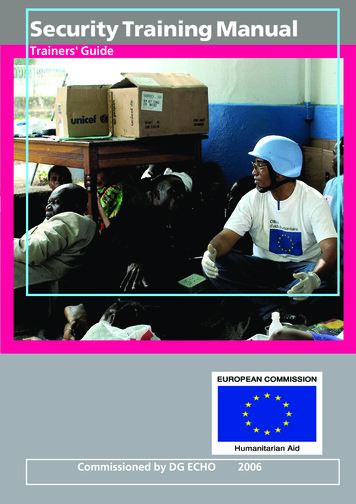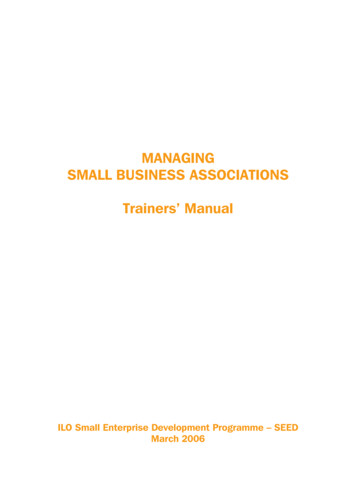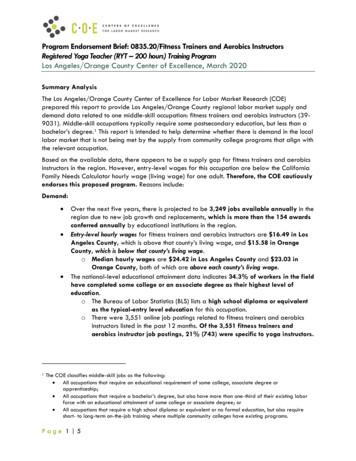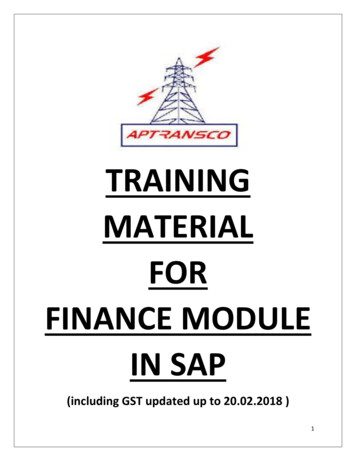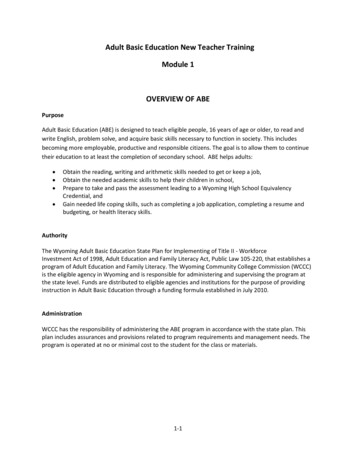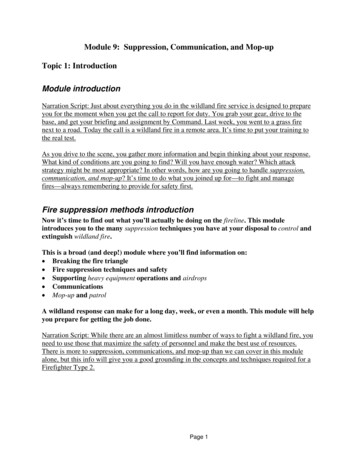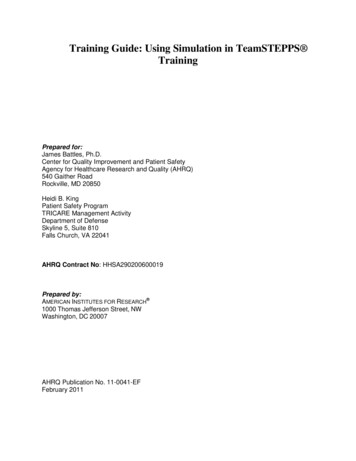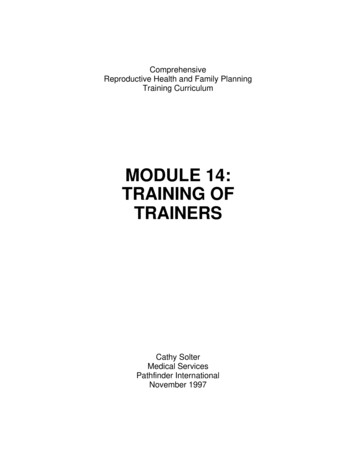
Transcription
ComprehensiveReproductive Health and Family PlanningTraining CurriculumMODULE 14:TRAINING OFTRAINERSCathy SolterMedical ServicesPathfinder InternationalNovember 1997
1997 Pathfinder International. Any part of this document may be reproduced oradapted to meet local needs without prior permission from Pathfinder Internationalprovided Pathfinder International is acknowledged, and the material is madeavailable free of charge or at cost. Please send a copy of all adaptations from thismanual to:Medical Services UnitPathfinder International9 Galen Street, Suite 217Watertown, MA 02472Funds for this Comprehensive Reproductive Health and Family Planning TrainingCurriculum were provided in part by the Agency for International Development(USAID). The views expressed are those of Pathfinder International and do notnecessarily reflect those of USAID.
TRAINER'S MANUAL
APPENDIX
ACKNOWLEDGEMENTSThe development of the Comprehensive Family Planning and Reproductive HealthTraining Curriculum, including this module, is an ongoing process and the result ofcollaboration between many individuals and organizations. The development processof this curriculum began with the privately-funded Reproductive Health Program (RHP)in Viet Nam.The entire comprehensive training curriculum was used to train service providers in1995 under this cooperative project which included Pathfinder International, IPAS,AVSC International, and the Vietnamese Ministry of Health. Individual modules wereused to train service providers in: Nigeria (DMPA); Azerbaijan, Ethiopia, Kenya, Peru,Tanzania, and Uganda (Infection Prevention); Azerbaijan, Kazakstan, and Peru(Counseling); and Jordan (PoPs & CoCs; IUD). Feedback from these trainings hasbeen incorporated into the training curriculum to improve its content, trainingmethodologies, and ease of use.With the help of colleagues at Pathfinder International, this curriculum has beenimproved, expanded, and updated to its present form. Thanks are due to: DouglasHuber, Ellen Eiseman, and Betty Farrell, who provided technical support and input;Penelope Riseborough, who provided technical editing and guidance on printing andpublication; Tim Rollins, Erin Majernik, and Carrie Hubbell who designed, formatted,and edited the document, and coordinated the process; Anne Read, who designed thecover; and Joan DeLuca, who entered numerous corrections and reproduced numerouscorrected pages. Participants in the Reproductive Health Project, and the developmentof this curriculum for its initial use in Viet Nam, include the following:IPASTraci Baird, Rob Gringle, Charlotte HordDevelopment AssociatesJoseph DeeringThe Indian Medical AssociationInstitute for Reproductive HealthKristin CooneyJHPIEGO CorporationAnn Blouse, Rick SullivanAVSC InternationalJames Griffin, John Naponick, Cynthia Steele VermeFamily Health InternationalRoberto RiveraPathfinder InternationalTraining of Trainers Curriculum
Viet Nam Reproductive Health ProgramColleagues in the field of reproductive health reviewed the Training of Traines trainingmaterial and provided invaluable comments and suggestions. These reviewersincluded:Kate BourneBui Thi ChiEllen EisemanRob GringleNghiem Vien HongRick SullivanNinuk WidyantoroLe Than ThuyJamie UhrigKamil MelikovIzzet ShamkolovaFaiza AllevaLaila KerimovaZemfira TopcubasovaJuiletta MirbakirovaPathfinder International, Viet NamViet Nam Reproductive Health Program TrainerPathfinder InternationalInternational Projects Assistance Services (IPAS)Viet Nam Reproductive Health TrainerJohns Hopkins Program for International Education inReproductive Health (JHPIEGO)Consultant to Pathfinder InternationalViet Nam Reproductive Health Program TrainerConsultant to Pathfinder International, Viet NamPathfinder International, AzerbaijanMinistry of Health, AzerbaijanBaku Family Planning Center, AzerbaijanMedical University, AzerbaijanMedical University, AzerbaijanMedical University, AzerbaijanSpecial thanks are due to Pam Putney, who used her expertise as a clinical trainer tosignificantly improve this module through editing and the addition of training exercises,new methodologies, and materials.Pathfinder InternationalTraining of Trainers Curriculum
TABLE OF CONTENTSNotes to the Trainer. iPurpose . iDesign . i Suggestions for Use . i Informed Choice . ii Client's Rights During Clinical Training. iii Demonstration Technique . iv Do's and Don'ts of Training . v TRAINER'S MANUALUnit 1: Introduction. 1Introduction of Trainers and Participants . 3 Defining Participants' Expectations . 4 Determining Trainees' Needs. 5 Establishing a Positive Climate and Spirit of Cooperation . 6 Suggestions for Effective Participation . 7 The Goal of the Training of Trainers Course and Unit Objectives . 8 "Where Are We?" and "Reflections" . 9 Unit 2: Adult Learning . 11Principles of Adult Learning . 13Characteristics of Adult Learning . 14 Applying Adult Learning Theory to the Learning Process . 15 Principles that Influence the Learning Process . 18 Retaining and Recalling Knowledge . 20 Concentration and Attention Span . 22 Key Words and Concepts . 23 Cardinal Rules of Memory. 24 Learning Styles Inventory . 27 Unit 3: Facilitation Skills . 31Using of Verbal and Nonverbal Communication . 33 Using of Praise and Encouragement . 38 Providing Feedback . 39 Appropriately Using Closed and Open Questions . 41 Unit 4: Training Techniques . 43Describing Commonly Used Training Techniques . 45 Advantages and Disadvantages of Various Technique . 47 Implementing Different Training Techniques . 48 Unit 5: Using Training Aids. 49Training Aids: Definition, Uses, and Selection . 51 Advantages, Disadvantages, and Handling Tips on Training Aids . 53 Preparing Creative Visual Aids . 54 Pathfinder InternationalTraining of Trainers Curriculum
Unit 6: Planning for Training . 55Using a Training Needs Assessment in Developing a Training Session . 57 Conducting a Needs Assessment . 60 Differentiating Goals and Objectives. 61 Competency-Based Training. 63 Unit 7: Micro-Training . 65Conducting Micro-Training Sessions . 67 Managing Nervousness . 68 Feedback on Training Sessions. 70 Do's and Don'ts of Training . 71 Unit 8: Preparing for a Training Course . 73Developing Plans for a Training Course . 75 Unit 9: Evaluation of Training . 79The Purpose of Evaluation in Training . 81 Evaluation Methods. 84 Development of an Evaluation Tool . 85 APPENDIXParticipant Handouts: Unit 11.1:Course Expectations . 87 1.2:Training Needs Assessment . 88 1.3:Suggestions for Effective Participation. 92 1.4:"Where Are We?" and "Reflections" . 93 Participant Handouts: Unit 22.1:Principles and Characteristics of Adult Learning . 95 2.1a: Supplemental Information on Adult Learning . 96 2.2:Applying Adult Learning Theory . 98 2.3:Learning Principles. 100 2.4:Retaining and Recalling Information . 102 2.5:Recall and Retention . 103 2.6:Cardinal Rules of Memory . 104 2.7:Learning Styles Continuum . 106 2.8:Learning Styles Inventory . 107 2.8a: Learning Styles Inventory (Interpretation Sheet). 109 Participant Handouts: Unit 33.1:Verbal and Nonverbal Communication . 111 3.2:Praise and Encouragement . 113 3.3:Feedback. 114 3.4:Closed and Open-ended Questions . 115 Pathfinder InternationalTraining of Trainers Curriculum
Participant Handouts: Unit 44.1:Knowledge, Skills, and Attitudes . 117 4.2:Training Techniques. 118 Participant Handouts: Unit 55.1:Training Aids . 137 5.2:Drawings Misinterpreted by Rural Adults . 139 5.2a: Drawings Misinterpreted by Rural Adults (Answer Key) . 140 5.3:Types of Training Aids . 5.4:Preparing and Choosing Visual Aids. 145 Participant Handouts: Unit 66.1:Case Study . 147 6.2:Training Needs Assessment Form . 149 6.3:Goals and Objectives . 153 6.4:Competency-Based Training . 155 Participant Handouts: Unit 77.1:Helpful Hints . 157 7.2:Trainer E
The modules are designed to provide flexibility in planning, conducting, and evaluating the training course. The curriculum is designed to allow trainers to formulate their own training schedule, based on results from training needs assessments. The modules can be used independently of each other. The modules can also be lengthened or shortened depending on the level of .
